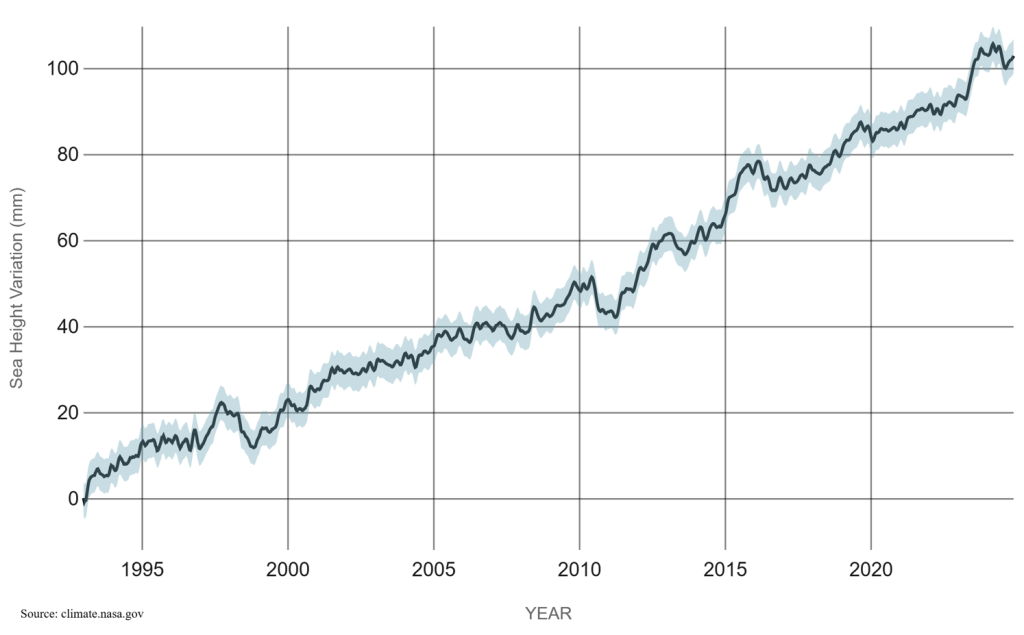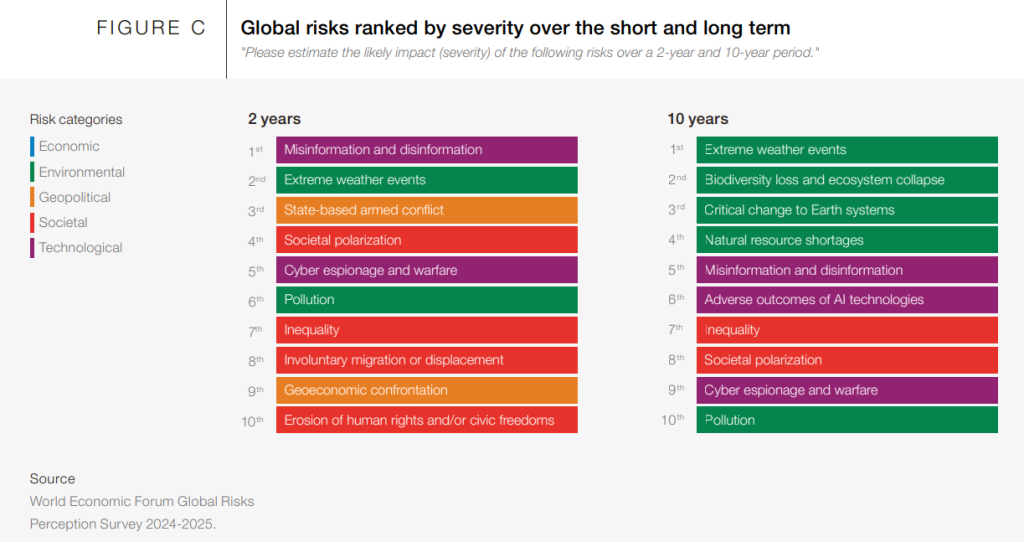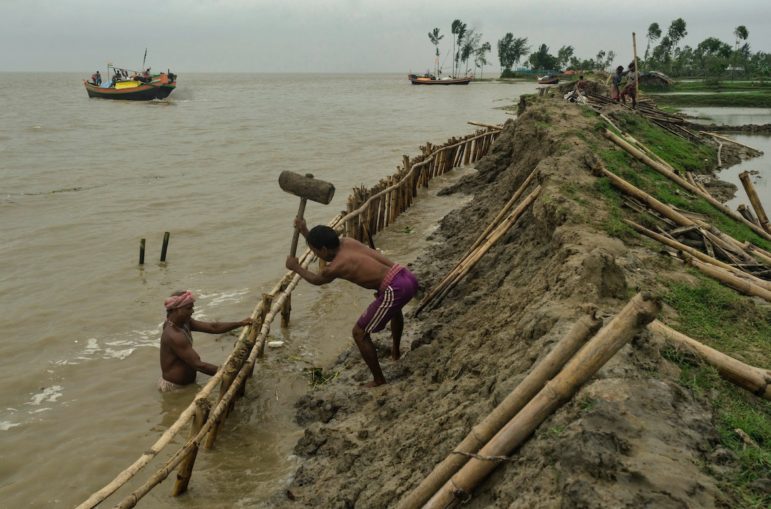Sea level rise is one of the most pressing consequences of climate change, with serious implications for coastal communities, ecosystems, and global economies.
As glaciers melt and ocean waters warm, sea levels are steadily increasing—reshaping shorelines, intensifying storms, and threatening millions of lives and livelihoods.
The Ultimate Guide to Sea Level Rise breaks down this complex issue in simple terms, offering a clear look at what’s causing the rise, how fast it’s happening, and what we can expect in the future.
Whether you’re a student, a concerned citizen, or just curious about the planet’s changing dynamics, this guide will equip you with the facts, science, and solutions behind one of the most critical environmental challenges of our time.
Read More: The Ultimate Guide to Sea Level Rise
What Is Sea Level Rise?
Sea level rise is the long-term increase in the average height of the ocean’s surface, measured relative to the Earth’s center. This global phenomenon is primarily driven by two key processes: the melting of land-based ice, such as glaciers and polar ice sheets, and the thermal expansion of seawater as it absorbs heat.
As global temperatures climb due to human-induced climate change, the Greenland and Antarctic ice sheets are melting at an accelerating pace, significantly contributing to rising seas. At the same time, warming oceans expand, further elevating sea levels.
Recognized as a fundamental indicator of climate change, sea level rise poses widespread risks to coastal infrastructure, ecosystems, and economies around the world.
Why Is Sea Level Rise in the Spotlight Now?
Global attention has intensified on sea level rise following a NASA-led analysis in 2024 that revealed a concerning acceleration. While scientists had projected a 0.43 cm increase for the year, actual measurements indicated a rise of 0.59 cm—an alarming deviation.
This rapid escalation underscores the mounting challenges faced by vulnerable regions, particularly Pacific island nations such as Tuvalu, Kiribati, and Fiji, which have long been grappling with the encroaching ocean.
NASA now forecasts an additional 15 cm of sea level rise in these regions over the next 30 years, even under optimistic emissions scenarios.
The urgency of the situation prompted world leaders from low-lying and small-island states to convene at the 2024 UN General Assembly’s High-Level Week, marking the first-ever dedicated session on sea level rise.
Key outcomes included plans for a 2026 declaration, collaboration on risk-monitoring technologies like AI, strengthened scientific cooperation, and a groundbreaking treaty between Australia and Tuvalu aimed at preserving Tuvalu’s statehood in the face of disappearing coastlines.
As Tuvalu’s Prime Minister stated, this moment offers a historic chance to “turn the global tide” and protect the rights and dignity of all affected communities.
How Is Sea Level Measured?
Sea level measurement has evolved significantly over time. Traditionally, tide gauges—still found in ports and harbors worldwide—have been used to track changes in sea level relative to land. Today, satellite altimetry provides a far more precise and comprehensive method.
By bouncing radar signals off the ocean surface, satellites can detect minute changes in sea level across the globe, enabling scientists to monitor long-term trends with greater accuracy.
Because local weather, currents, and geographic variations can cause temporary fluctuations, measurements are averaged globally to provide a more reliable picture of sea level rise.

The World Economic Forum has emphasized the importance of Earth observation technologies like these for vulnerability analysis, particularly in tracking environmental risks.
Between 1993 and 2024, satellite data from agencies like NASA shows that global sea levels have risen by over 10 centimeters.
Notably, in 2021, scientists detected a distinct “sea-level fingerprint” from the melting Greenland ice sheet—patterns in sea level variation that reflect shifts in the distribution of water and ice on Earth.
Alarmingly, the Greenland ice sheet is currently losing approximately 9 billion liters of ice every hour, according to the Geological Survey of Denmark and Greenland.
How Much Are Sea Levels Rising?
Sea levels are rising at an alarming pace, with scientists warning that the planet is approaching a critical threshold. The Greenland ice sheet, a major contributor to global sea level rise, is now believed to be nearing a tipping point of irreversible melting.
Current projections estimate an unavoidable global sea level increase of 1 to 2 metres in the coming decades. NASA reports that since 1993, sea levels have already risen by over 10 centimeters, marking the fastest rate of rise in the last 2,500 years.
Though these changes may seem modest—often measured in centimeters or even millimeters—they carry profound consequences. Even small increases significantly amplify the impact of storm surges, enabling floodwaters to reach further inland and endangering coastal communities around the world.
What Causes Sea Level Rise?
Sea level rise is primarily driven by two key processes: the melting of land-based ice—such as glaciers and ice sheets—and the thermal expansion of seawater as it warms. According to the U.S. National Oceanic and Atmospheric Administration (NOAA), both of these processes are intensifying as global temperatures rise.
A significant concern lies in the presence of potential feedback loops that could accelerate ice melt. One of the most alarming examples is the Thwaites Glacier in Antarctica, often referred to as the “doomsday glacier.”
Its rapid disintegration threatens to unleash over three meters of sea level rise if it collapses along with its stabilizing ice shelves. NASA estimates that heat stored in the ocean accounts for between one-third and one-half of observed global sea level rise.
The ocean has absorbed more than 90% of the excess heat generated by greenhouse gas emissions since 1971, and 2023/2024 marked the highest ocean temperatures on record since at least 1800. This immense heat absorption is a critical driver behind the accelerating changes in sea levels worldwide.
The Relationship Between Sea Level Rise and Climate Change
Climate change is the fundamental driver behind the ongoing rise in global sea levels. As global temperatures climb, polar ice caps and glaciers melt at accelerated rates, adding vast quantities of freshwater to the oceans.
Simultaneously, the warming of ocean waters leads to thermal expansion, where seawater increases in volume as it heats—further elevating sea levels.
This intricate relationship between climate change and sea level rise is critical to understand, as it underpins our ability to forecast future trends and implement effective mitigation and adaptation strategies.
As global warming persists, the rate of sea level rise is projected to intensify, placing increasing pressure on vulnerable coastal communities.
According to the World Economic Forum’s Global Risks Report 2025, “critical change to Earth systems” ranks as the third most severe threat over the next decade, with sea level rise from collapsing ice sheets identified as a major contributing factor.
Effects of Global Sea Level Rise
The impacts of global sea level rise are far-reaching and deeply interconnected, affecting both human societies and natural ecosystems. Coastal infrastructure—such as roads, bridges, and buildings—is increasingly at risk, leading to substantial costs in maintenance, adaptation, and potential reconstruction.
As sea levels rise, coastal flooding is becoming more frequent and severe, accelerating erosion and enabling saltwater intrusion into freshwater aquifers. This not only compromises drinking water quality but also threatens agricultural productivity in affected regions.
The World Economic Forum’s white paper Water Futures: Mobilizing Multi-Stakeholder Action for Resilience highlights water pollution from extreme weather events as a growing concern, while offering five strategic pathways to bolster water resilience.
Natural ecosystems are equally vulnerable. Coastal habitats like mangroves, salt marshes, and coral reefs—which serve as vital buffers and biodiversity hotspots—face increasing degradation.
Sea level rise also drives climate-induced displacement, forcing communities in low-lying areas to abandon homes and livelihoods, creating complex socio-economic challenges and straining public services.
Mitigating these effects demands holistic and proactive adaptation strategies that combine engineering, policy reform, community engagement, and ecosystem protection to safeguard both people and the planet.
Economic and Social Impacts
The economic and social consequences of sea level rise are profound, with long-term implications for communities, industries, and governments worldwide.
As coastlines become increasingly vulnerable, substantial investments are required to implement protective infrastructure such as sea walls, flood barriers, and drainage systems—imposing growing financial burdens on both public and private sectors.
Beyond infrastructure costs, the loss of property, homes, and livelihoods due to coastal erosion and flooding can destabilize entire communities.
Low-lying regions often home to economically marginalized populations are especially at risk, facing displacement, loss of income, and deteriorating access to essential services.
Industries such as tourism, fisheries, and agriculture, which depend on stable environmental conditions, may experience significant disruptions. Rising seas can degrade fertile land, contaminate freshwater sources, and damage marine ecosystems, ultimately threatening food security and local economies.
Moreover, forced migration caused by sea level rise can place additional pressure on urban centers and social infrastructure, heightening inequality and potentially sparking political and economic instability.
Understanding and addressing these cascading effects is essential to shaping equitable, resilient adaptation strategies that prioritize at-risk populations and foster sustainable development.
Past Sea Level Rise and Historical Context
Throughout Earth’s geological history, sea levels have experienced significant fluctuations, particularly during the last ice age and the subsequent warming period. However, the current rate of sea level rise stands as unprecedented in both speed and scale.
Since 1890, global average sea levels have risen by approximately 21-24 cm, a rate far surpassing historical averages, as reported by the U.S. National Oceanic and Atmospheric Administration (NOAA).
This rapid acceleration is primarily driven by human-induced climate change, particularly the burning of fossil fuels, which has significantly increased greenhouse gas emissions and contributed to the melting of ice sheets and the thermal expansion of seawater.
Understanding historical patterns of sea level rise is crucial for predicting future changes and developing adaptive strategies. By analyzing past data, scientists can discern the natural variability of sea levels and, more importantly, assess the extent to which current trends are driven by human activities.
Countries Most Vulnerable to Rising Sea Levels
In 2023, the UN identified several nations at significant risk from rising sea levels, including Bangladesh, China, India, and the Netherlands, where nearly 900 million people reside in low-lying coastal areas facing heightened vulnerability.
According to NASA, regions such as the East Coast and Gulf Coast of the U.S., as well as parts of Asia and various islands, are particularly susceptible to the impacts of rising oceans.
Beyond the gradual increase in sea levels, storm surges are becoming more extreme, reaching higher water levels and extending further inland, exacerbating the damage.In specific regions, such as Tonga, sea levels are rising nearly twice the global average.

In Europe, the European Environment Agency predicts that sea levels will rise by more than 10 cm by 2050. In the U.S., research shows that over 1,100 critical buildings in coastal communities could face monthly flooding by 2050, with some areas potentially becoming uninhabitable within just two to three decades.
Global risks associated with climate change, particularly sea level rise, are among the most pressing challenges of our time. It ranks as one of the ‘Critical Changes to Earth Systems’ and is considered the third-highest threat to the world over the next decade.
Adapting to Rising Sea Levels: Global Strategies and Efforts
According to the Glasgow Climate Pact, developed nations must significantly increase climate adaptation finance, aiming for at least $40 billion annually.
However, even if this target is met, the United Nations Environment Programme estimates that the funding gap for necessary adaptation measures will still range between $187 billion and $359 billion per year, reducing the shortfall by only 5%.
In response to this challenge, nations and cities across the globe are implementing various adaptation strategies. For instance, New Zealand is developing climate adaptation policies that ensure new public housing is not constructed in areas vulnerable to climate hazards.
Meanwhile, countries like Denmark, Germany, and the United Kingdom are investing in strengthening their coastal defenses, including sea walls, surge barriers, and other forms of protection, to safeguard against the impacts of rising seas.
Innovative Adaptation Strategies in Response to Rising Sea Levels
To tackle the growing threat of rising sea levels, several nations are exploring innovative solutions. South Korea and the Maldives are testing floating homes, offering a potential model for housing in coastal regions prone to flooding.
Meanwhile, countries like China and India are implementing techniques to capture and store stormwater for reuse, helping to mitigate the impact of heavy rainfall and flooding.In Fiji, more drastic measures are being taken.
The government has begun planning the relocation of entire villages in response to rising seas. According to The Guardian, 42 villages have been earmarked for relocation, with six villages already moved to safer areas to preserve the safety and livelihoods of their populations.
Frequently Asked Questions (FAQs)
What is sea level rise?
Sea level rise refers to the gradual increase in the average level of Earth’s oceans due to the melting of ice sheets and glaciers and the thermal expansion of seawater as it warms. This rise in sea levels is primarily driven by human-induced climate change.
How fast are sea levels rising?
Since 1993, sea levels have risen by more than 10 cm globally. The rate of sea level rise has accelerated in recent years, with estimates suggesting that sea levels could rise by up to 1-2 meters by the end of this century, depending on future emissions and climate change scenarios.
Which areas are most at risk from rising sea levels?
Low-lying countries and regions are especially vulnerable. Nations like Bangladesh, China, India, and the Maldives face significant risks. The United States’ East and Gulf Coasts, as well as Pacific island nations, are also at high risk. In these regions, rising sea levels can lead to flooding, erosion, and the displacement of entire communities.
How is sea level rise measured?
Sea level rise is traditionally measured using tide gauges installed at various locations. However, modern methods employ satellites, which use radar to track changes in sea level globally with greater precision. Data from satellites can show long-term trends and reveal more localized variations in sea level changes.
What are the impacts of sea level rise?
Sea level rise affects both human and natural systems. It can damage infrastructure, increase flooding, lead to saltwater intrusion into freshwater supplies, and disrupt ecosystems such as coral reefs and mangroves. It also poses a threat to agricultural productivity and can lead to the displacement of millions of people.
What is being done globally to address sea level rise?
International efforts to tackle sea level rise are underway, with governments and organizations focusing on mitigation and adaptation strategies. The United Nations and other global bodies are working on agreements to reduce greenhouse gas emissions and support vulnerable regions with the necessary adaptation finance.
Conclusion
The rising of sea levels is one of the most pressing challenges posed by climate change, with far-reaching consequences for ecosystems, communities, and economies. Driven by the melting of glaciers and ice sheets, as well as the thermal expansion of seawater, sea level rise is already threatening low-lying areas, causing flooding, erosion, and saltwater intrusion into freshwater resources. The situation is expected to worsen in the coming decades, with vulnerable regions, particularly coastal cities and island nations, facing the greatest risks.

